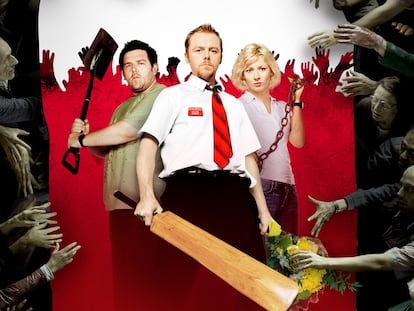‘It’s more disturbing than many horror movies’: How ‘Shaun of the Dead’ showed we’re zombies of capitalism
Twenty years have passed since the movie’s release. It is now seen as a multilayered modern classic, and has legions of fans calling for a sequel

If George A. Romero’s Night of the Living Dead (1968) reflected the racial tensions and distrust in institutions of late-1960s America, films like 28 Days Later (2002) and Dawn of the Dead (2004) drew on the documentary aesthetics of modern horrors to speak of the fragility of modern life and the speed at which a seemingly stable social order could crumble. In this context, the British comedy Shaun of the Dead — released in April 2004 in the United Kingdom and internationally in the autumn of that same year — became one of the most important films of the subgenre by proposing another twist: what if comfort and the dominant social order are already, at their base, deeply zombified?
Shaun of the Dead is a satire about the frustration of generational expectations. Twenty years after its release, it is still the most acclaimed movie by director Edgar Wright, and his leading duo, Simon Pegg and Nick Frost. The trio had previously worked together in the TV sitcom Spaced (1999), another comedy about young adults battling with job insecurity and the difficulty of finding an affordable place to rent. Shaun of the Dead — the trio’s film debut — was in fact inspired by a Spaced episode, where one of the characters experiences hallucinations as a result of a zombie video game. It also touched on many of the same themes.
Shaun of the Dead — a pun on the movie Dawn of the Dead — follows the fruitless efforts of an almost thirty-something, Shaun, to adapt to adult life. He hates his job, which has no prospect of improving, and his relationship with his girlfriend has been drained of all excitement, with the two going to the same bar every night to meet up with his best friend, the only one he seems to get along with. Between the sleepy passengers on the bus he takes to work, the drunks in the streets and the customers wandering the aisles of the supermarket with their vacant gazes, the first moments of the zombie epidemic go practically unnoticed by Shaun, who is unable to distinguish certain situations from how society normally works. After his girlfriend threatens to leave him, Shaun decides to put his life in order and grow up. And that is when the zombie invasion begins: from this perspective, the fact that the characters are forced to constantly develop plans and strategies to survive among the zombies, sometimes blending in with them, takes on a disturbing meaning.
“One of the reasons why Shaun of the Dead is still so popular is that, although it is a comedy, it is not a parody. It is scarier and more disturbing than many strictly horror films,” says Clark Collis, a journalist for Entertainment Weekly and author of the book You’ve Got Red On You: How ‘Shaun of the Dead’ Was Brought to Life.
Collis highlights that Wright and Simon Pegg — who is also the co-writer as well as an actor — are passionate fans of the genre, and are well-versed on the subject. In addition to exploring the same metaphors as George A. Romero — whose movie Dawn of the Dead follows the survivors of a zombie outbreak as they barricade themselves in a shopping mall — the film also contains multiple references to Italian horror films. For example, a restaurant is named Fulci’s — in homage to Lucio Fulci, the director of the classic Zombi (1979) — and music by Goblin, a progressive rock group that did the soundtrack to Dario Argento’s masterpieces. Romero was amused by the Shaun of the Dead allusions: after calling Wright to congratulate him, he invited the director and the actor to make a cameo as zombies in his next film, Land of the Dead (2005).
Here, surviving
Over the years, Edgar Wright has often joked about the fact that the Spanish title of Shaun of the Dead is Zombies Party, claiming that he had a poster of the Spanish version of the movie in his home.
I have a large framed poster for ZOMBIES PARTY.
— edgarwright (@edgarwright) April 9, 2020
The joke went even further when, in his next film, Hot Fuzz (2007) — a name that was also dramatically changed in Spain to Arma Fatal or “Fatal Weapon” — he introduced a copy of the Spanish DVD into a scene. Hot Fuzz was the second part of what would be called the Three Flavours Cornetto trilogy, named after the movies’ passing references to the ice cream. Each movie is linked with a flavor: strawberry for Shaun of the Dead, classic for Hot Fuzz and mint for the last in the series, The World’s End.
The three films address similar themes and generational concerns, such as the fear of growing up and the well-founded reasons for not wanting to fit into the status quo. Seen in hindsight, the trilogy is also an insightful look into British society before Brexit, touching on issues like reactionary nostalgia, extreme conservatism, xenophobia, nationalism, white supremacy and gentrification.
“I think the secret sauce of the Cornetto trilogy is that each film explores serious themes, whether it be family and urban life in Shaun of the Dead, or addiction and conformist pressures in The World’s End. But they are never thought of as films about important issues, because they are also very funny,” says Collis.
For example, in a journal article, academics Kathryn A. Cady and Thomas Oates argued the Shaun of the Dead “imagines a single-generation heteronormative family as the outcome of zombie invasion,” drawing parallels between zombies and the routine of capitalist culture.
The movie not only focuses on the mechanical processes of day-to-day life, which Wright captures in hyper-quick close-up shots, it also has a series of recurring jokes about these routines. For example, every time Shaun is asked how he is doing in the film, he replies: “Surviving.”
In 2017, British journalist David Jenkins wrote that the core of the Three Flavours Cornetto trilogy was “a fear of cultural alienation,” describing Hot Fuzz as the “ultimate anti-Brexit film.” “You wouldn’t necessarily think of Wright as a political filmmaker,” he said. “The characters he builds are unabashed cinematic constructs whose traits feed off of silver screen lore more than they do documentary reality [...] [But he speaks of how] rejecting progress can be dangerous, and so can clinging to a false sense of nostalgia for a time that never was or a place that never existed. In the end, Wright just wants us all to drive safe.” Jenkins also mentioned Wright’s movie Baby Driver (2017), another story about nostalgia, and the fear of leaving behind a toxic, yet familiar, way of life.
After the Three Flavours Cornetto trilogy, Wright became a major studio director, despite the commercial failure of his first U.S. movie, Scott Pilgrim vs. the World (2010), which has since won a cult following, and a disagreement with Marvel, which fired him from Ant-Man (2015) due to creative differences. Meanwhile, Pegg returned to co-starring in comedies alongside Nick Frost, albeit with less success, and has established himself as a key supporting actor in franchises such as Mission: Impossible (since the third movie in 2006) and Star Trek (since 2009).
While both revived their Shaun of the Dead characters to offer health recommendations and support the lockdown measures during the Covid-19 pandemic, Pegg has flatly rejected the possibility of a sequel.
In a 2023 interview with The Guardian, the actor seemed to have taken the coming-of-age lessons of his trilogy to the extreme, claiming that he’d rather watch Succession than sci-fi and that he’d moved on from a lot of what people assume he is about. “I don’t feel like I’m that geeky guy any more,” he said. “If I ever do an Instagram Live or whatever, people are always like, ‘I need Shaun of the Dead 2 in my life.’ And I’m like, ‘No, you don’t fucking need Shaun of the Dead 2! The last thing you need is Shaun of the Dead 2! It’s done. Move on!’” Pegg, it appears, has grown up, just like Shaun wanted to.
Sign up for our weekly newsletter to get more English-language news coverage from EL PAÍS USA Edition
Tu suscripción se está usando en otro dispositivo
¿Quieres añadir otro usuario a tu suscripción?
Si continúas leyendo en este dispositivo, no se podrá leer en el otro.
FlechaTu suscripción se está usando en otro dispositivo y solo puedes acceder a EL PAÍS desde un dispositivo a la vez.
Si quieres compartir tu cuenta, cambia tu suscripción a la modalidad Premium, así podrás añadir otro usuario. Cada uno accederá con su propia cuenta de email, lo que os permitirá personalizar vuestra experiencia en EL PAÍS.
¿Tienes una suscripción de empresa? Accede aquí para contratar más cuentas.
En el caso de no saber quién está usando tu cuenta, te recomendamos cambiar tu contraseña aquí.
Si decides continuar compartiendo tu cuenta, este mensaje se mostrará en tu dispositivo y en el de la otra persona que está usando tu cuenta de forma indefinida, afectando a tu experiencia de lectura. Puedes consultar aquí los términos y condiciones de la suscripción digital.
More information
Archived In
Últimas noticias
New York enters the era of Zohran Mamdani
Welcome to the post-religion era: The idea of Christianity as the absolute truth has become obsolete
‘I thought you would like it’: The risky sexual practice popularized by TV shows and TikTok
The digitalization of tourism: ‘They promise experiences and gave us the worst possible one’
Most viewed
- Sinaloa Cartel war is taking its toll on Los Chapitos
- Reinhard Genzel, Nobel laureate in physics: ‘One-minute videos will never give you the truth’
- Oona Chaplin: ‘I told James Cameron that I was living in a treehouse and starting a permaculture project with a friend’
- Why the price of coffee has skyrocketed: from Brazilian plantations to specialty coffee houses
- Silver prices are going crazy: This is what’s fueling the rally











































